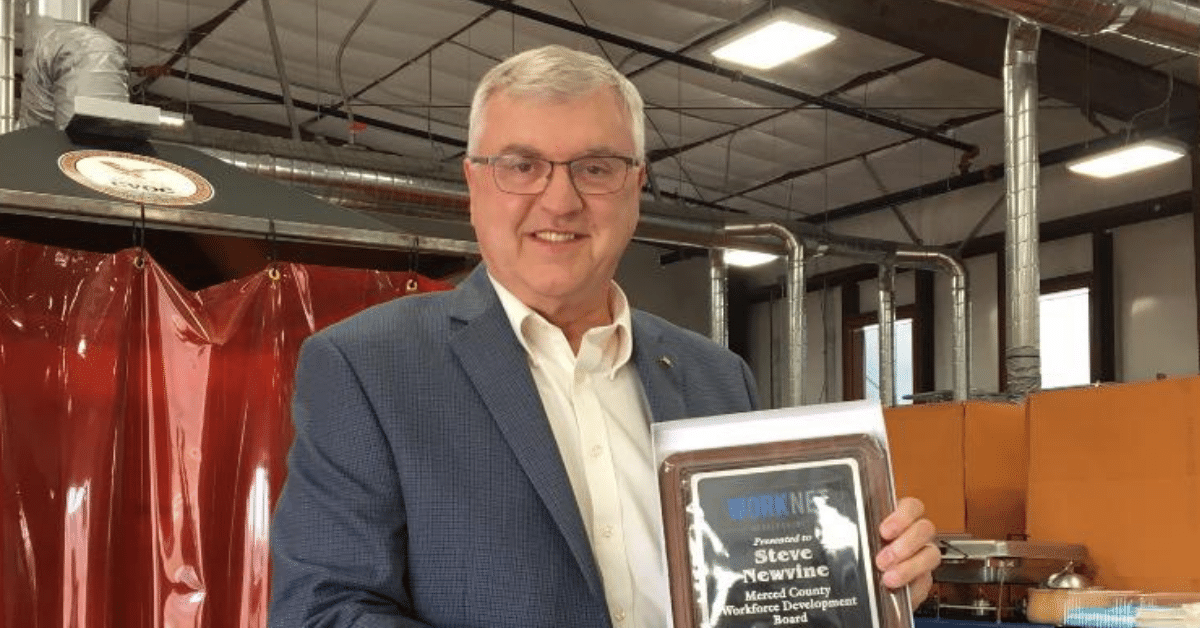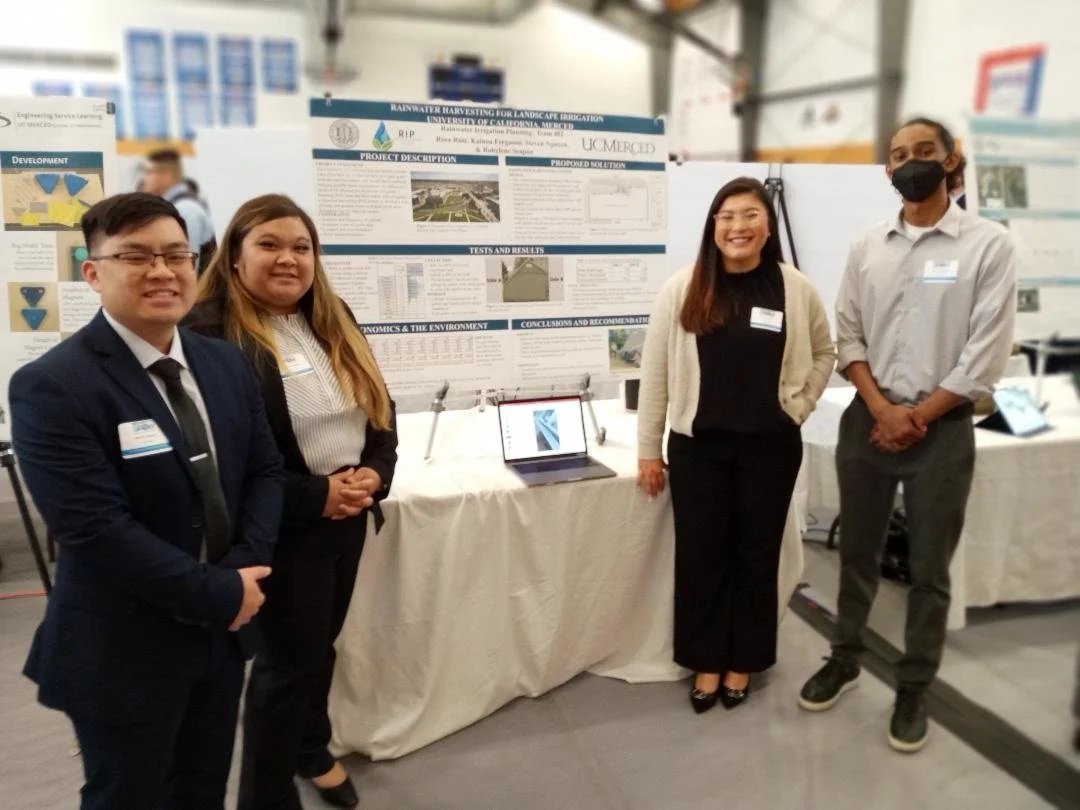
Student Innovation Flowing Forward-
Water reuse among many ideas at UC Merced engineering event
This student team from UC Merced’s Innovate to Grow event designed a water recovery solution for the campus. Photo: Steve Newvine
During their four years as students at UC Merced, Rosa Ruiz and Robylene Seapno, had a strong enthusiasm for environmental sustainability.
As the newest campus in the state system, UC Merced was built to the highest sustainability standards in place back in the early 2000s.
For Rosa, part of the attraction to this new facility was the focus on making the best use of natural resources.
“I had a real interest in this,” Rosa said.
So it did not surprise these two when they paired up with two other students with similar views on conservation to work on an engineering solution that could help the entire campus community.
The four comprised a team within the School of Engineering who, along with other student teams, developed engineering solutions to problems facing manufacturers, ag producers, and non-profit organizations.
The UC Merced student team with their test-of-concept solution site on the campus. L-R: Rosa Ruiz, Kainoa Ferguson, Robylene Seapno, & Steven Nguyen. Photo: Rainwater Irrigation Planning team, UC Merced
The workgroup was among sixty-six student teams that showcased their findings to teachers, clients, and business community representatives at the annual Innovate to Grow final presentations held on May 13.
The projects ranged from aggregating data from cropland microcomputers to improvements in early childhood learning tools. More than two hundred students worked on these projects throughout the semester. They met with real clients, traveled on-site when necessary, and worked on their problems collaboratively under the supervision of their professors.
“The students delivered great projects,” said UC Merced, Director of Innovation Stefano Foresti.
The UC Merced Gymnasium was headquarters for a tradeshow like project presentation held in the morning of the annual Innovate to Grow event. Later in the day, each group presented specific findings of their research to judges in individual classrooms. Photo: Steve Newvine
The problem facing this particular student team was rainwater, and how to engineer a way to capture what little rain falls on the campus, and use that water for landscaping and other needs.
Campus leaders are considering installing a rainwater harvesting system.
Right now, the only source of water for the campus comes from the City of Merced. The City’s water system does not utilize non-potable water.
The engineering team was given the task to address the goal of UC Merced’s leadership to design a system that will capture and use non-potable water to irrigate green areas on campus.
The proposed design location for the system is the Academic Office Annex building. The team calculated that an annual rainwater collection of 54,000 gallons could happen with the right solution.
To demonstrate the solution, a proof of concept a prototype was designed and installed at the UC Merced Community Garden. That prototype is expected to collect about 400 gallons of rainwater annually.
The students created a rainwater capture and storage concept using a small storage shed already on the campus as their prototype location.
Their analytics showed that saving the water and storing it can be done. Recommendations for more water-resistant plants and shrubbery were also entered into the calculations.
The University and the School of Engineering are satisfied with the team that took on the challenge. It’s hoped that their work can be passed on to another student team in the fall semester to take the research up to another level.
According to Rosa, “We are not giving up.”
The student team proved that a water capture and storage project can be done, but at this time the solution may not be cost-effective. Right now, it is less expensive to buy the water the campus might need for this effort from the City of Merced than it would be to build and maintain a system for the project.
This project will likely be turned over to a future Innovate to Grow team in hopes that an even better solution can be found.
That’s what innovators do. They keep trying.
For Rosa, Robylene, and the rest of their team, there was a great deal of satisfaction in knowing they were part of a much bigger challenge to make the best use of the Valley’s water supply.
Steve Newvine lives in Merced.
His current book A Bundle of Memories is available at Lulu.com.
Four of his books are now available via author search on bookshop.org where each purchase helps independent book store owners.
Sequoia Legacy Tree Stands Proudly in Visalia-
Challenges in providing proper care
The Sequoia Legacy Tree in Visalia, California. Photo: Steve Newvine
In a sense, this is a story about two guys who shared an office and an idea.
Let’s go back to another time. It’s wintertime in 1936 in the quaint small city of Visalia, California in Tulare County about ninety miles south of Merced.
Nathan was the Postmaster in a newly opened Visalia Post Office. Guy was the Superintendent of General Grant National Park in the Sierra Mountains. During the winter, the Superintendent shared workspace in the post office alongside Nathan.
Guy brought two small Sequoia trees to the office one day during that winter season of 1936. The pair thought re-planting the three-year-old trees on opposing sides of the new post office building might give the downtown area a little natural beauty.
They also hoped maybe the trees might encourage others to head up into the mountains to see more of the stately trees in the National Park.
The trees grew and grew.
By 1940, General Grant National Park was folded into what we now know as Kings Canyon National Park. The area where visitors can find the General Grant tree is now known as the General Grant Grove.
Nathan and Guy went about their work. Both kept an eye on the post office trees throughout their careers and beyond.
One challenge lingered during the first fifty years the two sequoias adored the sides of the Visalia Post Office. One of the trees became diseased and had to be cut down in the mid-1980s.
But the other one continued to grow. Outliving both Nathan and Guy, that tree is now a very special part of the community.
With a history going back to the 1930s, the downtown Visalia Sequoia, better known as the Sequoia Legacy Tree, is a unique part of this city.
Four years ago, the City formally dedicated the Sequoia Legacy Tree.
The Sequoia Legacy Tree can be found at the corner of of Acequia Avenue and Locust Street in downtown Visalia. Photo: Steve Newvine
The Tree is the focal point of a pocket park at the corner of Acequia Avenue and Locust Street in downtown Visalia. Interpretive signs explain the story and get into some of the challenges in the care and feeding of a majestic tree that are normally found in the Sierra Nevada.
The granite pathway the circles the tree is the approximate diameter of the General Sherman Tree in Sequoia National Park. Sequoia National Park is adjacent to Kings Canyon National Park.
This tree has a lot more growing to do.
Keeping the Sequoia Legacy Tree healthy and growing is a complication as it grows on the floor of the San Joaquin Valley far away from the majestic Sierra mountain range.
In the mountains, the sequoias take in water that flows from the snowpack in higher elevations. On the valley floor, the Sequoia Legacy Tree depends on water from the City of Visalia water department.
It also depends on the time and attention paid to it from both the public works department and volunteers who keep watchful eyes on any signs of danger that might pose a threat.
There is a sign near the tree reminding visitors that it is really up to each of us to use our water wisely to protect and conserve.
That may have been what both Guy and Nathan were thinking back in the mid-1930s when they made it possible for a sequoia to have a regular presence in one of our valley cities.
Steve Newvine lives in Merced and travels throughout the San Joaquin Valley to find stories of interest to readers.
He’s published several books including California Back Roads where he examines more than three-dozen special places throughout Central California. The book is available at Lulu.com













To explore Steve Newvine's complete collection of books, simply click on the link below.
CLICK HERE
Steve is also open to delivering speeches for service club programs and other public speaking engagements.
Contact him at: SteveNewvine@sbcglobal.net